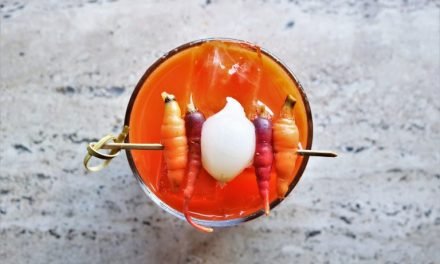
The Pairing Project: State Foods with State Wine – Part 6 of 10

Part 6 takes us through four Ohio River border states and up to Michigan. As someone who grew up in Cleveland, Ohio, these midwestern and southeastern states bring memories of wooded backyard barbeques and front porch happy hours. The ethnic foods and handheld delights take me back to street vendors at football games and cultural festivals. Join me as we eat in and around my old stomping grounds.
West Virginia
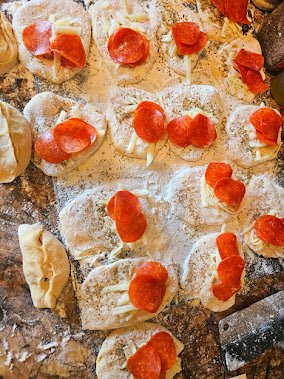
Pepperoni Rolls Prep ©Darla Hoffmann
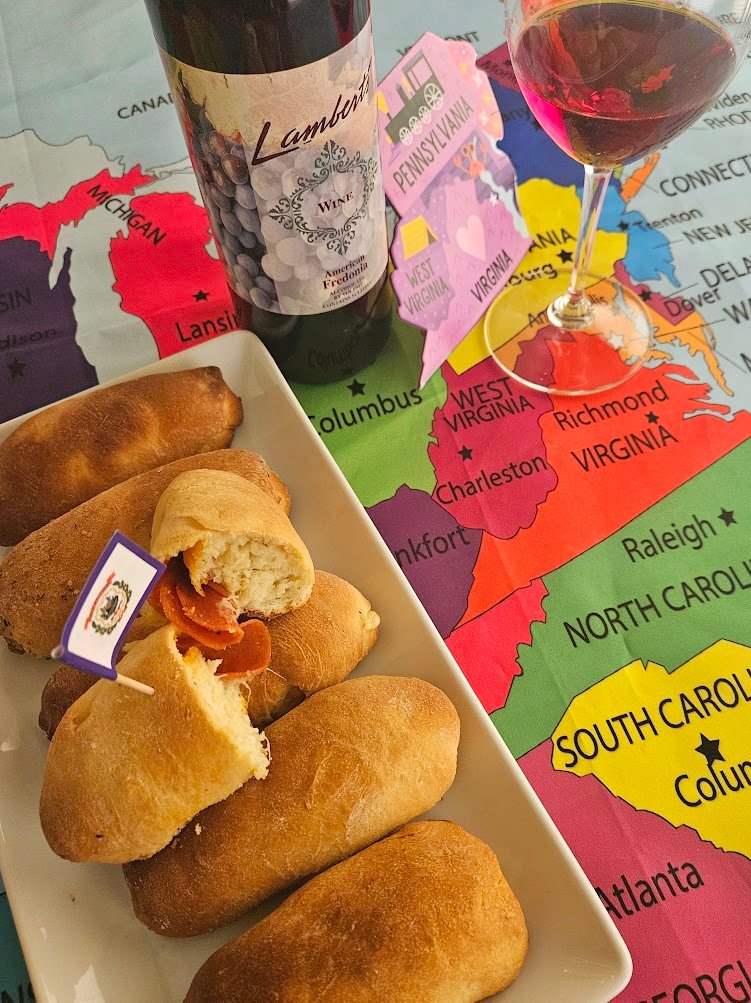
West Virginia Pepperoni Rolls paired with Lambert’s Fredonia ©Darla Hoffmann
The story of the pepperoni roll dates back to the early 20th century — Italian immigrants were drawn to West Virginia by the booming coal mining industry. Miners would eat sticks of pepperoni and pieces of bread for a simple yet filling meal. Seeking a convenient, easily packed lunch in the coal mines, they began wrapping slices of pepperoni in bread dough and baking them. Bakeries got wind of the creation and added cheese, butter, and spices. Now, aromas of the now-iconic pepperoni roll drift through the state.
I am starting to get the hang of making dough, as this project has required me to do so on several occasions. I combined warm water and yeast and slowly added butter, eggs, sugar, salt, and flour, then let the sticky dough sit for a few hours in the fridge. Once ready, I cut the dough into 18 palm-size pieces, rolled each with cheese, pepperoni, garlic salt, and Italian spices filling, brushed with melted butter, and baked for 18 minutes.
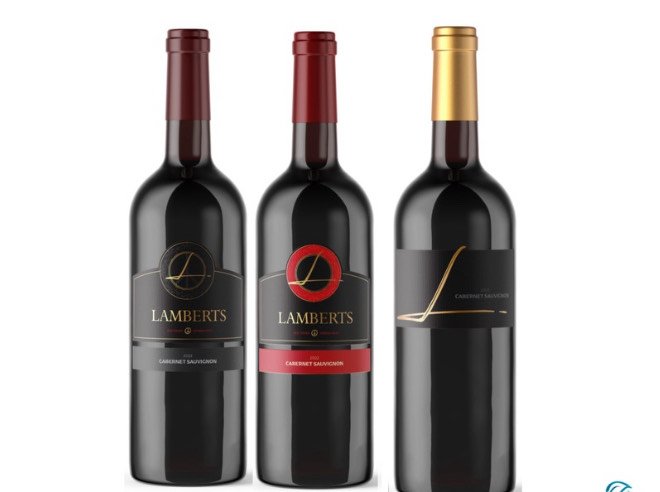
Bottle Shots at Lambert Winery ©Lambert Winery
Jim Lambert of Lambert’s Winery took the time to curate a wine to pair with their infamous dish. He sent me a white Niagara and a red Fredonia from which to choose. I picked the Fredonia; the fragrant wine with juicy red fruit flavors of plum and cherries, sweet tomatoes, and a honeyed spiciness was a superb match for the buttery, salty, meaty pepperoni roll.
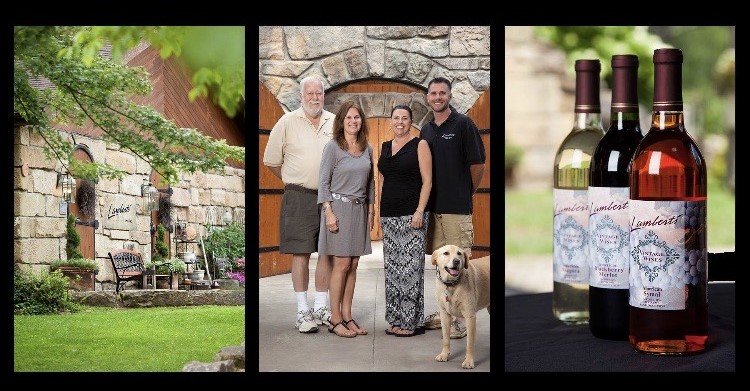
Lambert’s Winery, located in the tiny central city of Weston, sits on a hillside surrounded by its vineyard. The tasting room, made from hand-cut stones, is intimate and welcoming. The owners, Jim and Debbie, thought of every detail so you could enjoy their wines in a comfortable setting. They offer winery tours, and their picturesque medieval-like property is available for weddings and events.
Pennsylvania
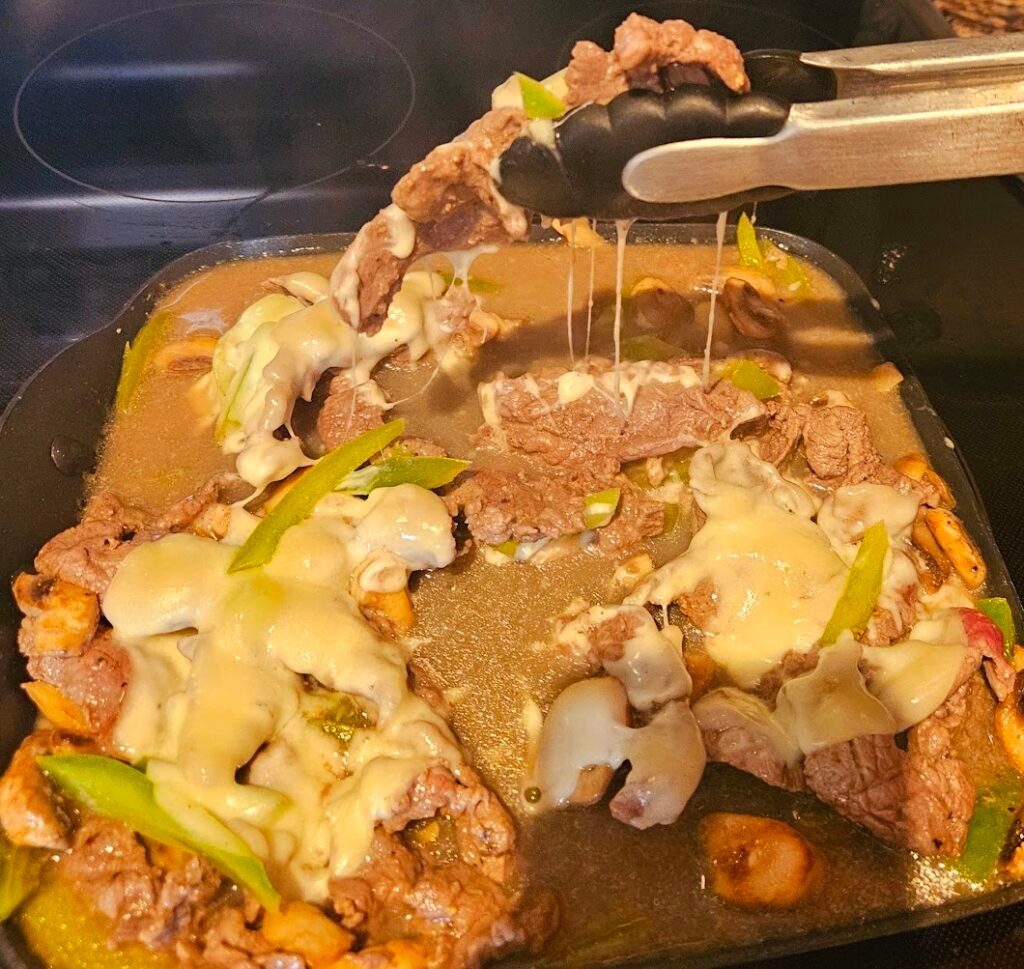
Philly Cheese Prep© Darla Hoffmann
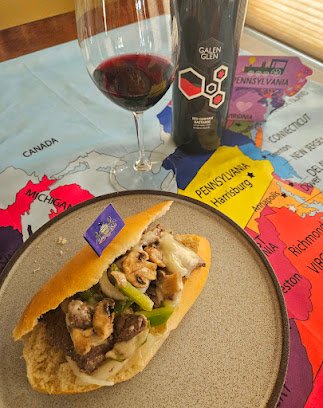
Pennsylvania’s Philly Cheese Steaks paired with Galen Glen’s German Bastard red blend ©Darla Hoffmann
The history of the beloved Philly cheesesteak sandwich dates back to the early 20th century in Philadelphia, Pennsylvania. It is said that the sandwich was invented by Pat Olivieri, a hot dog vendor near South Philadelphia’s Italian Market, who decided to put some sliced steak onto a roll one day in 1930. He then added some onions and melted cheese, usually provolone or cheese whiz, to create what has become a staple in Philadelphia cuisine. The sandwich’s popularity soared, and the city’s renowned Pat’s King of Steaks soon emerged as a go-to place for the best cheesesteaks in town.
This sandwich was easy enough to make. I shaved some ribeye steak, sauteed it with onions, mushrooms, and bell peppers, topped it with provolone (I couldn’t do cheese whiz), bundled it together in the pan, and scooped it onto a large hoagie.
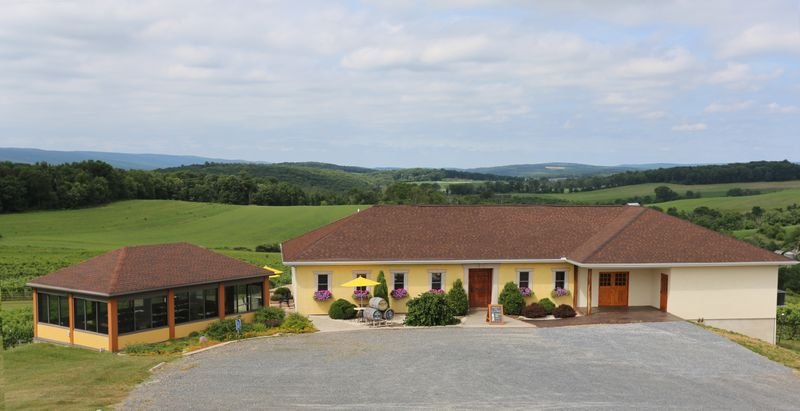
Galen Glen Winery ©Galen Glen
The folks at Galen Glen Winery in Andreas, Pennsylvania, sent me their Red German Bastards, a 50/50 blend of Zweigelt and Cabernet Dorsa, to make the pairing. The spicy wine, with its vibrant acidity, vegetal notes, and abundance of fresh wild berries, harmonized perfectly with the gooey meatiness and bell peppers of the Philly Cheesesteak.

Work at the Galen Glen Vineyard ©Galen Glen
Galen Glen is located about an hour and a half north of Philadelphia, on the fringes of the Leigh Valley American Viticultural Area. With a combined background in mechanical engineering, chemistry, and farming, owners Galen and Sarah established their winery in 1995 on the family farm. Their daughter, Erin, heads the winegrowing team and is a 7th generation in farming their land. The trio and their team welcome you to visit their tasting room — ask about their Inside climate-controlled Pavilion for classes and events!
Ohio

Boiling the Pierogis ©Darla Hoffmann

Ohio’s Potato and Cheese Pierogis paired with Ferrante’s Chardonnay ©Darla Hoffmann
Pierogi, the dumpling typically filled with a savory or sweet filling, has its roots in Polish cuisine. It is believed to have originated in Poland in the 13th century, where it was first mentioned in a cookbook. From there, the Pierogi made its way to other countries, such as Ukraine, Russia, and Slovakia.
Along with Eastern European immigrants in the early 1900s, the Pierogi came to the United States of America. The first documented pierogi sale was in 1928 at the Marton House Tavern in Cleveland, Ohio, where it was served to unemployed steel mill workers. It is now the iconic ethnic star dish at festivals in the state.
The Pierogi can be a finicky recipe to perfect, but I managed to get most of my batch to stay closed and presentable. I mashed the potatoes while my dough was resting to prepare my filling. Once ready, I rolled the dough and cut it into 3-inch circles using a cookie cutter, then filled one side with potatoes and aged cheddar cheese, folded it into a semi-circle, and crimped the ends with a fork. Finally, I boiled the pierogis for about 4 minutes – as they floated to the top of the water, they were ready to be paired with a delicious wine.
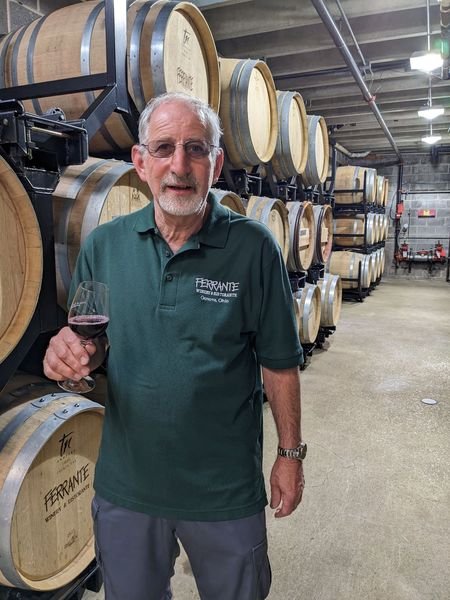
Nick Ferrante, Owner ©Ferrante Winery
Ferrante Winery, of my beloved home state, sent me their Signature Series 2021 Chardonnay for the pairing. The soft, buttery wine with hints of green apples, ripe peaches, hazelnuts, and baking spices of vanilla and caramel was the ultimate match for the savory, rich, cheesy Pierogi.

Ferrante Dinner and Wine on property ©Ferrante Winery

Tasting at Ferrante in Ohio ©Ferrante Winery
Ferrante’s 40-acre vineyard and 80 years of farming tradition are in the American Viticulture Area of the Grand River Valley – about 45 minutes northeast of Cleveland. Third-generation brothers, sisters, and extended family work in their state-of-the-art winemaking facility and ristorante in Geneva, Ohio. A visit to taste wine and indulge in delectable Italian food on their beautiful grounds is a must when exploring this region’s wine! Inquire about their live music and events.
Kentucky
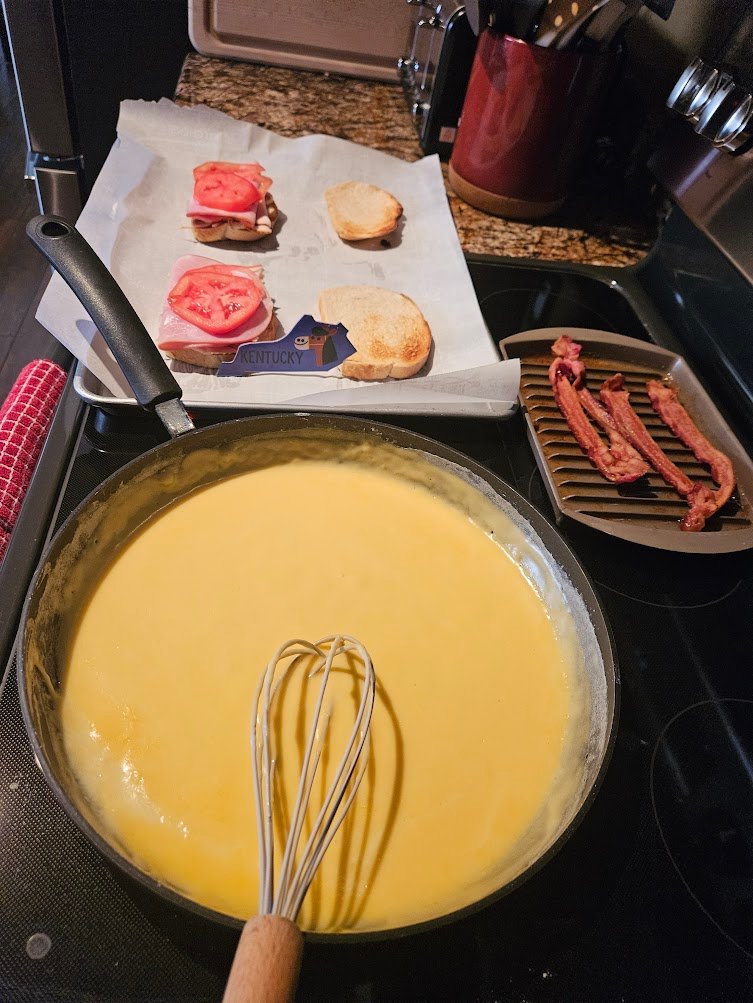
Prepping Hot Brown Cheese Mixture ©Darla Hoffmann

Kentucky Hot Browns paired with Ghost Fox Zinfandel ©Darla Hoffmann
The Kentucky Hot Brown is a legendary dish that originated in Louisville, Kentucky, in the 1920s. Created at the historic Brown Hotel, this open-faced sandwich quickly became a classic in the local culinary scene and beyond.

Hotel Chef Fred K. Schmidt invented the Hot Brown as a late-night snack for the hotel’s hungry dancing guests. Schmidt wanted to create a new dish that was both satisfying and tasty from what he had on hand—thus, the Hot Brown was born. The original recipe featured sliced turkey, Mornay sauce, and bacon on a thick slice of toast, topped with a sprinkle of Parmesan cheese and a tomato slice. The dish was then broiled until the cheese was bubbly and golden brown.
I followed an easy recipe with sourdough bread, turkey, ham, bacon, and, of course, the melted butter and cheese topping. I baked it for about 8 minutes, and it was ready for a wine pairing.

Ghost Fox Wine Awards ©Ghost Fox
Ghost Fox Winery generously sent me their Old Vine Zinfandel; it was spot on to stand up to the Hot Brown. The wine’s blackberry and raspberry liqueur flavors with baking spices of cinnamon and nutmeg balanced the dish’s richness and cheesy, comforting goodness. Ghost Fox can give the wineries in Lodi, California, a run for their money with this wine!

Tasting Room at Ghost Fox ©Ghost Fox
Owners of Ghost Fox, Josh and Mallory, have been making wine for over a decade, finally opening their own winery in 2023. They both have past lives that include the United States Marine Corps, chemistry, and vineyard management, but their beliefs in magic, good wine, and the sly wisdom of the fox brought them to where they are now. You can taste the wines at their property in Nicholasville, about an hour and a half southeast of Louisville—come join in on the many events they host, including a Kentucky Derby Festival!
Michigan

Coney Dogs ©Darla Hoffmann

Coney Dogs paired with Ciccone Vineyards Dolcetto ©Darla Hoffmann
The origin of the coney dog traces back to Greek immigrants who settled in Detroit and opened their restaurants. These Greek entrepreneurs quickly recognized the hot dog’s popularity and began serving their version topped with flavorful chili and onions. The term “coney” often refers to a spicy chili sauce popular in Greek cuisine.
A Greek man named Gust Keros (who came to Detroit looking for work in the auto industry) is often credited with starting the trend of serving chili dogs in his restaurant, American Coney Island, in Detroit. He named it after the famous Coney Island in New York. The restaurant still exists today and is run by his granddaughter, the family’s third generation. I guess it was a blessing that Keros couldn’t find a gig working on cars.
I boiled the hot dogs, cooked some ground beef, sauteed the onions and spices, put it in a bun, and topped it with cheese and mustard. There you have it—the famous coney dog.
What to pair with the all-American dish was the question. I knew Traverse City, Michigan, is the state’s popular wine region, so I contacted the winery I was most familiar with, Ciccone Vineyard & Winery. They sent me a bottle of their Dolcetto, an aromatic fruit-forward dry red wine that happily married the Coney Dog. The rich plum and licorice flavors, spicy undertones, and firm tannins gave the savory, salty dog the mate it was looking for.
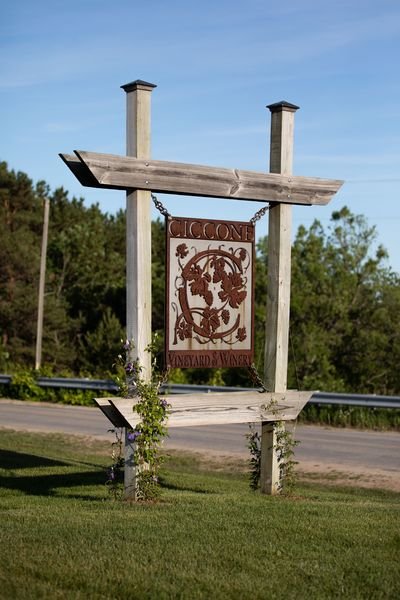
Welcome to Ciccone Vineyards ©Ciccone Vineyards

Vineyards at Ciccone TVC ©Ciccone Vineyards
Ciccone Vineyard & Winery has been family-owned and operated since 1995. First-generation American and son of Italian immigrants, Silvio “Tony” Ciccone and his wife Joan dabbled with a few rows of backyard grapevines for years. Upon retiring, they made their dream of owning a vineyard a reality in Traverse City, Michigan. Daughters Paula and Jennifer are now at the helm and are making 100% estate award-winning wine. (Unrelated to wine, but a fun fact – Silvio is also the father of the iconic singer Madonna).

Rows of Vines at Ciccone in TVC ©Ciccone Vineyards
At Ciccone Vineyard & Winery, the family invites you to savor their wines in the cozy indoor tasting room or amidst the picturesque vineyard views in the outdoor tasting area. Reservations are only necessary for larger groups, ensuring a personalized experience for all visitors.
Part 6 definitely gave us some food of substance. Nobody is losing any weight with too many helpings of these dishes, but it sure is fun to revisit small portions of them from time to time. As I head south for part 7, I must tell you ahead of time to bring your sweet tooth! 30 states down—20 to go!
Click here for the next chapter in the Pairing Project series.
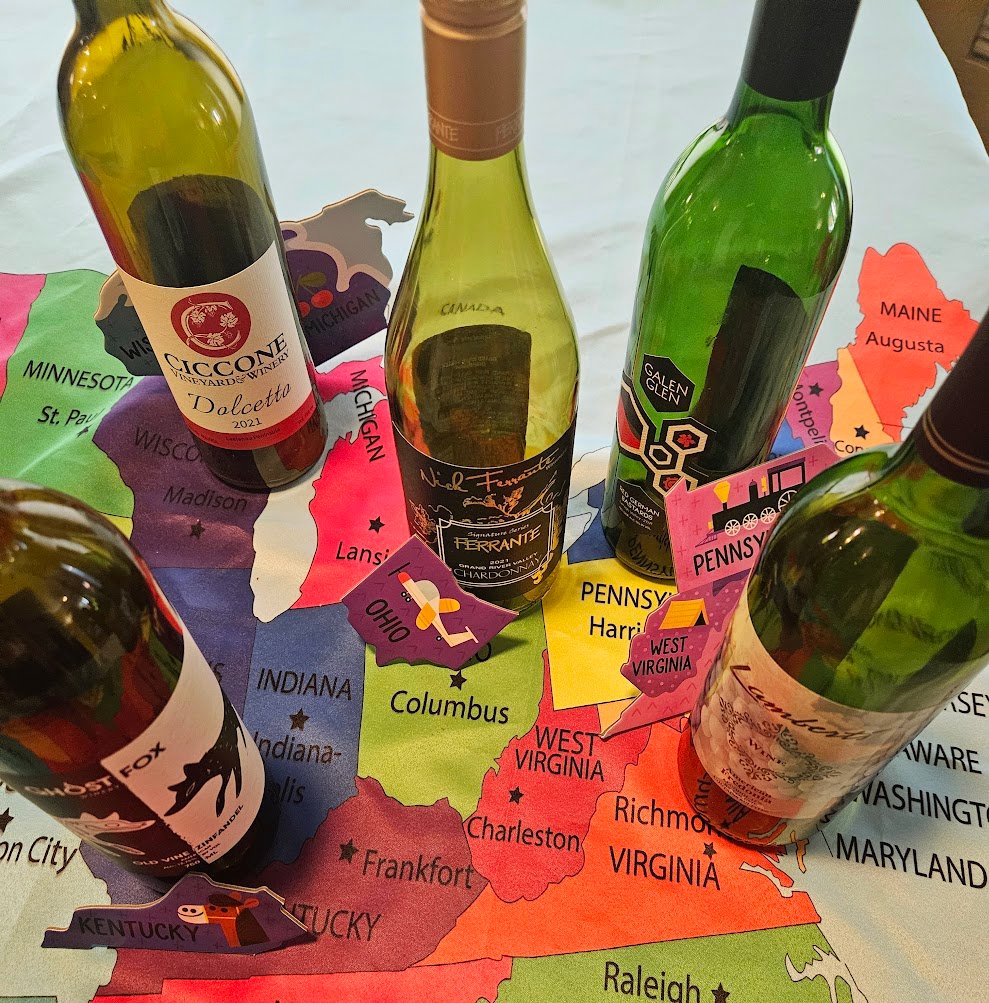
Part 6 Wine Choices ©Darla Hoffmann











